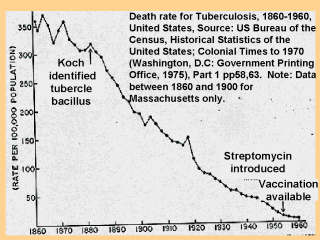| front |1 |2 |3 |4 |5 |6 |7 |8 |9 |10 |11 |12 |13 |14 |15 |16 |17 |18 |19 |20 |21 |22 |23 |24 |25 |26 |27 |28 |review |
 |
Author: John Last, Canada
http://www.pitt.edu/~super1/lecture/lec2561/007.htm Death rate for Tuberculosis, 1860-1960,
United States, Source: US Bureau of the Census, Historical Statictics of the United
States; Colonial Times to 1970 (Washington, D.C.:Government Printing Office, 1975), Part 1
pp58,63. Note: Data between 1860 and 1900 for Massachusetts only. Ecological
Determinants of Disease. Prosperity led to improved housing conditions and better nutrition. Literacy increased. It became less common for several children in the family to share the same bed. Being well-fed, better housed, well-informed, and separated from others by enough space to reduce the probability of person-to-person transmission of infection, all helped to reduce the burden of premature death. Perhaps there was also a rise in the natural (maternal to infant) level of immunity to some of the infections that had previously carried off huge numbers of infants and children, and a decline in the virulence of some of the most lethal pathogens. |